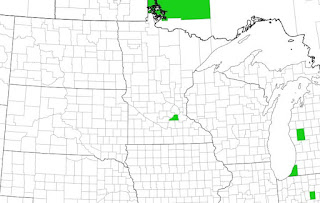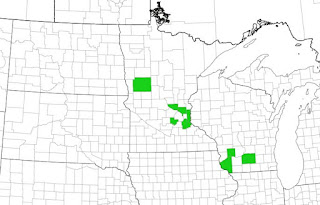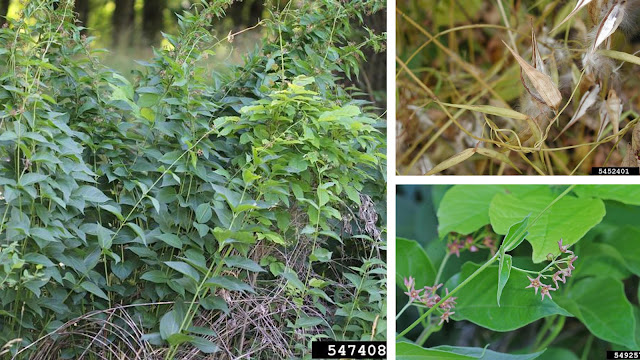The Minnesota Department of Agriculture has added several
new plants to its 2023
noxious weed list. This post focuses primarily on additions to the
Prohibited-Eradicate category, but three other categories – Prohibited-Control,
Restricted and Specially Regulated – are covered at the end of the post.
Prohibited-Eradicate: The Early-Detection List
The plants in this group either aren’t here yet or are
present in low numbers. They're in the early-detection stage, when ideally, they can be found and removed before they
become widespread. As the name of the group suggests, these plants should be eradicated by destroying
all above- and below-ground parts. Transporting, propagating or selling them is
illegal.
Three plants are new to the list this year: Johnsongrass,
pale swallow-wort and red hailstone.
Sorghum halepense
 |
| USDA NRCS Plants Database (see references). Johnsongrass is confirmed in counties shaded blue. Lakes and rivers are also shaded blue. |
habitats, including pastures, roadsides, ditches, old fields and wetlands. It reproduces by seeds and rhizomes and can spread aggressively to form dense mats that exclude other plants. It will not tolerate drought or extreme cold, so where winters are severe, Johnsongrass may be a facultative (optional) annual. Stressed plants can produce toxic levels of cyanide.
Johnsongrass grows 8-12 feet tall when flowering. Leaves are
alternate, hairless and up to 2 feet long with white midribs. Ligules are 3-4
mm long, membranous and sometimes toothed. Johnsongrass flowers from mid-summer to fall
in loose, purplish panicles.
Leaves of Amur silvergrass (Miscanthus sacchariflorus),
another introduced plant, also have white midribs, but this plant is shorter at
6-8 feet. Its ligules are a hairy fringe, and its panicles are silvery and
silky in fall.
 |
| Clockwise from left: Johnsongrass stem and dense stand by Chris Evans, University of Illinois, Bugwood.org; Johnsongrass rhizomes and panicle by Steve Dewey, Utah State University, Bugwood,org. |
Cynanchum rossicum (aka Vincetoxicum rossicum)
 |
| EDDMapS (see references). Pale swallow-wort is confirmed in counties shaded green.The plant has also been confirmed in Ontario. |
to the U.S. in the late 1800s, probably as an ornamental. It thrives in disturbed sites but can grow in a variety of habitats, including fields, pastures and woodland edges and understories. Fast-growing and shade tolerant, it can quickly overrun and outcompete other plants. Because swallow-wort is in the milkweed family, female monarchs will sometimes lay their eggs on it if common milkweed is unavailable. There is concern, however, that swallow-wort is toxic to monarch larvae.
The vine has opposite, shiny, oval or heart-shaped leaves
with pointed tips. Stems grow to 7 feet long, wrapping around other plants or
structures for support or clambering over the ground. Sap is clear, not white. Clusters
of pink to reddish-brown, star-shaped flowers bloom in June and July. Pods are
slender, smooth and 2-3 inches long.
Black swallow-wort (Cynanchum nigrum) is also on the
Prohibited-Eradicate list. It looks like pale swallow-wort but has dark purple
flowers.
Red hailstone
Thladiantha dubia
 |
| EDDMapS (see references). Red hailstone is confirmed in counties shaded green. |
in the late 1800s or early 1900s as an ornamental. This adaptable plant grows in abandoned fields, roadsides, gardens, crop fields, railroad corridors and natural areas. Red hailstone can quickly overgrow and smother other plants, including crops.
Vines grow up to 20 feet long with tendrils that grasp
other plants or structures for support. Leaves are alternate and heart-shaped.
Stems, leaves and petioles (leaf stalks) are hairy. Yellow, tubular flowers
bloom from July to September on separate male (pollen-producing) and female
(seed-producing) plants.
So far, all plants found in Minnesota are male, so the vines
aren’t spreading by seed. Instead, they reproduce vegetatively by small tubers carried
along waterways; many of the mapped infestations are along rivers or streams. Where
both male and female plants grow, 2-inch oblong fruits may form on female
vines. The fruits turn red when mature, thus the name red hailstone.
Before it flowers, red hailstone resembles other
tendril-bearing vines in the same family. Wild cucumber (Echinocystis lobata)
is a hairless vine with five-lobed leaves and white flowers that bloom in late
summer. Bur cucumber (Sicyos angulatus) is hairy but also has five-lobed
leaves. Its flowers are white or greenish-white. Neither cucumber vine has red
fruits.
 |
| Clockwise from left: Red hailstone leaves and infestation by Katy Chayka, Minnesota Wildflowers; Red hailstone flowering plants by Peter Dzuik, Minnesota Wildflowers. |
 |
| Clockwise from left: Red hailstone flowers by Peter Dzuik, Minnesota Wildflowers; male flower closeup by Katy Chayka, Minnesota Wildflowers; rhizomes and tuber by Katy Chayka, Minnesota Wildflowers. |
Other Categories of Noxious Weeds
The MDA defines three other categories of noxious weeds. Two
were expanded in 2023.
· Prohibited-Control: Plants in this category are already established here, so eradication isn’t practical. Management aims at preventing them from reproducing by seed or vegetative organs, such as rhizomes, tubers or stem fragments that can take root. Transportation of all propagating parts is illegal except as allowed by state law, and the plants may not be propagated or sold in the state. Sixteen species are on the list, including three kinds of knotweed featured in a previous post, Are Psyllids the Solution to Invasive Knotweeds? No new species were added in 2023.
· Restricted: These plants are widespread in Minnesota. The only practical way to manage them is to restrict their importation, sale and transportation in the state, except as allowed by state law. Two plants are new to the list this year: lesser celandine (Ficaria verna), an aggressive spring ephemeral and garden escapee, and salt cedar (Tamarix ramosissima), also called tamarisk, a shrub first introduced in the West for landscape use, windbreaks and erosion control.
· Specially Regulated: These are native or nonnative weeds that are economically valuable but potentially harmful if not controlled. Three plants are new to the list this year. Amur corktree (Phellodendron amurense) now must be removed wherever females have been planted or escaped, or their fruits and seeds must be prevented from spreading. Only male cultivars are legal to sell. Production of Callery pear (Pyrus calleryana) is being phased out over the next three years, after which the tree will be moved to the Restricted category. Tatarian maple (Acer tataricum) and its cultivars can be sold only if a label is attached advising that they should be planted only where the seedlings can be controlled, and ideally at least 100 yards away from any natural area.
References
EDDMapS. 2023. Early Detection & Distribution Mapping
System. The University of Georgia - Center for Invasive Species and Ecosystem
Health. Available online at http://www.eddmaps.org/; last accessed March 20,
2023.
USDA, NRCS. 2023. The PLANTS Database
(http://plants.usda.gov, 03/23/2023). National Plant Data Team, Greensboro, NC
USA.
Johnsongrass
Wisconsin
Department of Natural Resources
Minnesota
Department of Agriculture
USDA
Fire Effects Information System
Pale swallow-wort
Minnesota Department of Agriculture
Wisconsin Department of Natural
Resources
Michigan Department
of Natural Resources
Red hailstone
Minnesota
Department of Agriculture
University
of Minnesota Extension Service






